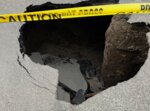

Good news. Minneapolis is back in the top 10. According to Extreme Weather Watch, this winter ranks third for the largest snowfalls ever recorded with 89.9 inches. And it's only April.
The most snow Minneapolis ever got is 98.7 inches in 1983–1984. So there's still hope of being No. 1.
After a tough couple of years, Minneapolis has taken a hit in the livability rankings. The city could use a morale boost, and it's nice to see Minneapolis trending upward in something other than vandalism, car thefts and disgruntled citizens.
There is no official data for disgruntled citizenry, but based on Nextdoor, Facebook and Twitter comments, Minneapolis leads the world in civic dysfunction.
Plenty of people are doing their part to contribute. As Earthjustice reports: "Human activity is causing rapid changes to our global climate that are contributing to extreme weather conditions.
"When fossil fuels are burned for electricity, heat, and transportation, carbon dioxide, a greenhouse gas that traps solar radiation, is released into our atmosphere.
"Over the past century, massive increases in carbon dioxide, methane, and other greenhouse gas emissions have caused the temperature on our planet to rise. That spike in global temperatures is fueling climate disasters that will only get worse unless we take action. Experts warn that we are running out of time to dramatically cut pollution to avoid climate catastrophe."
Despite the high level of snowfall, Minnesota is getting warmer. Daily average minimum temperatures during winter (December-February) increased 7.3 degrees from 1895-2021 in northern Minnesota, 6 degrees in central Minnesota and 4.9 degrees in southern Minnesota, according to the Minnesota Pollution Control Agency. The years ahead are expected to bring warmer temperatures.
Don't bet against Mother Nature. Especially when she's pissed. Hell hath no fury like a woman scorned, and Mother Nature could make "Fatal Attraction" Glenn Close look like Mother Theresa.
All this extreme weather takes a toll on streets, wastewater facilities, businesses, homes, farms, and natural resources. It can cost millions of dollars in cleanup and repairs. That impacts the economy, natural environment and quality of life.
We got a taste of it this winter with big temperature swings. Freezing one day, balmy the next. This bipolar freeze-thaw cycle, mixed with rain, wreaked more havoc on infrastructure than usual.
Have you seen our roads?
First, it was potholes. Now, it's sinkholes.
On Easter Sunday, a huge crater opened up in the middle of Girard Avenue and 27th Street in Uptown Minneapolis. The sinkhole was 5 feet wide, 10 feet deep, and caused by a broken clay sewer pipe from 1903, the Star Tribune reported. The 120-year-old sewer pipe could not handle the brutal freeze-thaw cycle and fast snowmelt this year. Utility workers replaced it with a permanent new PVC pipe within days, and the street is expected to be back to normal by late April.
Patching up all of the other potholes in the city will take longer. Minneapolis doled out an extra $1 million to provide temporary street patches before permanent fixes can be made when asphalt plants open in the spring. Longer-term repavements are part of a citywide 20-year street funding plan.
The Minnesota Department of Transportation, via the Star Tribune, explained the science behind all the potholes. When ice and snow melt, water gets into a street through cracks in the asphalt. When water freezes again and expands, the pavement explodes. Cars drive over the broken pavement and cause the pavement to break more, creating holes in the streets.
Extreme weather creates a more extreme freeze-thaw cycle and increases the production of potholes. Old, decaying streets are most susceptible. Anyone who has driven a car on a Minneapolis street since January has experienced the joy of potholes and gotten plenty of off-road training for the Baja 500.
I witnessed the sinkhole firsthand on my bike, returning home from an afternoon ride. A neighbor said, "You probably see that, but watch out." A police officer said, "Don't fall in."
The season of street craters isn't over.
Now that the snowmelt season has started for good, be prepared. That is advice from the National Weather Service.
"The combination of multiple rain events along with snowfall and wildly fluctuating temperatures have wreaked havoc on pavement throughout the region. Areas where water has been standing at times this winter are even more likely to have damaged road surfaces. So this year, more than ever, it is important to *Turn Around, Don't Drown* when you encounter a flooded roadway, even if the water is standing and not flowing. You have no idea what the road surface is like under that water, if it is even there."
In other words, protect yourself at all times. And do whatever you can to preserve a livable planet.
Oh, and watch out for sinkholes.
Comments
No comments on this item Please log in to comment by clicking here